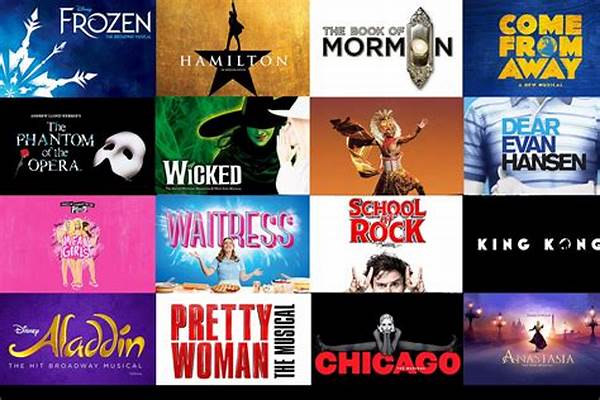In the heart of a dimly lit theater, as the final note reverberated through the hushed audience, a spellbinding silence enveloped the room. This was no ordinary conclusion; it was one of those memorable closures in musical productions that lingers long after the curtains fall. The cast took their bow, and the audience rose to their feet, their applause a resounding endorsement of an unforgettable journey. It was an ending that stitched the final threads to a tapestry woven with emotion, story, and sound—a perfect crescendo that defined a show.
Read Now : Tearful Curtain Call Audience Reactions
The Art of Crafting Memorable Closures
Creating memorable closures in musical productions requires a delicate balance of emotion, story, and musicality. These finales aren’t merely the end; they’re the culmination of a journey shared between storytellers and audience. When the lights dim, and the last note fades, what remains is the echo of an experience deeply felt. These closures must resonate, binding the audience to the narrative long after they leave the theater.
In well-crafted musical endings, every element plays a crucial role. Characters often reach pivotal realizations or complete their arcs, leaving a sense of fulfillment. The music swells, often reprising themes from earlier acts but with newfound depth—a musical handshake with the story. This combination ensures that the final moments are not just seen or heard but felt to the core. The best closures link every act into a coherent tale, making them truly memorable closures in musical productions.
Iconic Finale Moments
1. In “Les Misérables,” the finale encapsulates redemption and hope, echoing the journey of its characters, a benchmark in achieving memorable closures in musical productions.
2. “The Phantom of the Opera” offers an enigmatic conclusion, leaving audiences mesmerized and pondering long after the curtain falls.
3. “Cats” ends with a note of spirituality, lifting the audience with its ethereal symphony—a testament to memorable closures in musical productions.
4. “Hamilton” closes with a poignant reflection on legacy and memory, brilliantly intertwining history with personal stories.
5. “Wicked” concludes with a powerful sense of revelation and transformation, encapsulating the theme of its entire narrative journey—an unforgettable closure.
Weaving Emotion into the Finale
Every aspect of a production culminates in the finale—each note, lyric, and gesture leads to these final moments. Memorable closures in musical productions result from meticulously layering these elements to their peak. As the audience engrosses themselves in the world crafted before them, they experience a profound emotional crescendo as the closing scene approaches.
Musical finales must not only provide closure to the story but also elicit an emotional response that resonates with the audience’s own experiences and emotions. This emotional connection is the hallmark of memorable closures in musical productions. They bridge the gap between fiction and reality, allowing audiences to carry the story with them beyond the theater walls. By crafting a finale that echoes past the narrative, productions ensure their stories live on in the hearts of their audience.
The Lasting Impact of a Well-Executed Closure
Crafting memorable closures in musical productions often involves creating a final act that reverberates emotionally and thematically with the audience. Whether the story concludes with joy, sadness, or reflection, the impact of a strong finish is felt as audiences carry its essence with them.
1. Audiences yearn for closure—a sense that all narrative threads have woven together.
2. A powerful ending can redefine the entire narrative.
3. A poignant finale can elevate the storyline, making it legendary.
Read Now : Nostalgic Movie Soundtrack Elements
4. Audience applause and emotion signify the depth of connection achieved.
5. Memorable closures live on as timeless benchmarks in storytelling and production.
6. Curtain calls can transform endings into euphoric group celebrations.
7. Final moments shape the collective memory of a production’s impact.
8. Iconic finales can draw repeat viewings and cult followings.
9. Emotional crescendo ensures stories linger in audience minds.
10. These conclusions offer a seamless transition from fictional world to reality.
Understanding the Emotional Journey
The journey to memorable closures in musical productions is one marked by careful planning and heartfelt execution. From the first notes of the overture to the final bow, every moment is crafted with one goal in mind: to create a lasting impression. When characters face their final dilemmas and reach the apex of their arcs, audiences find themselves on the edge of their seats.
The power of a musical’s closure lies in its ability to encapsulate the essence of the entire production. It draws together themes, motifs, and character stories in a grand finale that resonates deeply within the audience. By marrying storytelling with melody, memorable closures can transform a simple night at the theater into a profound shared experience. As audiences exit, still abuzz from what they have witnessed, they carry with them the emotional weight of the journey—forever marked by the musical’s closing act.
Capturing the Essence of a Narrative
To achieve memorable closures in musical productions, creators focus not just on the narrative’s end but on capturing its very essence. A well-constructed finale distills the story’s core message and ensures it resonates beyond the confines of the theater.
Through their meticulously crafted finales, musical productions achieve a form of storytelling that transcends the page, merging spectacle with sentiment. Each memorable closure serves as a reminder that every aspect of the musical—every note, every lyric, every performance—was part of a greater whole. As the final curtain descends, the echoes of these tales linger in the hearts and minds of all who have witnessed them, a testament to the enduring power of theatrical storytelling.
